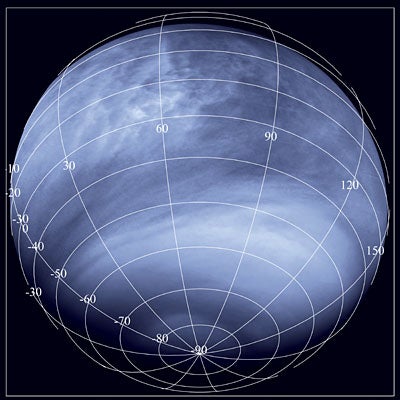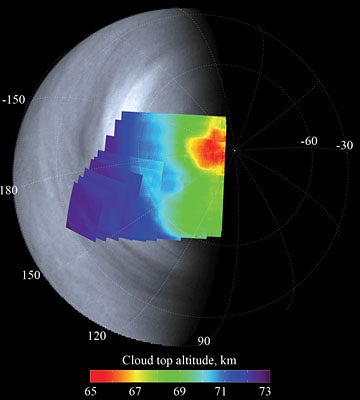A pale yellow dot to the human eye, Venus comes to life in the ultraviolet and the infrared. New images taken by instruments on board the European Space Agency’s (ESA) Venus Express provide insight into our neighboring planet’s turbulent atmosphere.
Venus Express lets scientists compare what the planet looks like in different wavelengths, giving them a powerful tool to study the physical conditions and dynamics of the planet’s atmosphere.
Observed in the ultraviolet, Venus shows numerous high-contrast features. The cause is the inhomogeneous distribution of a mysterious chemical in the atmosphere that absorbs ultraviolet light, creating the bright and dark zones.
The ultraviolet reveals cloud structure and the atmosphere’s dynamical conditions in the atmosphere and the infrared provides information on the cloud tops’ temperature and altitude.
Infrared observations have been used to map the altitude of the cloud tops. Surprisingly, the clouds in both the dark tropics and the bright mid-latitudes are located at about the same altitude of about 45 miles (72 kilometers). At 60° south, the cloud tops start to sink, reaching a minimum of about 40 miles (64 kilometers), and form a huge hurricane at the pole.
Infrared images overlaid on ultraviolet images bring the giant hurricane’s eye at the planet’s south pole to life. Its center is displaced from the pole and the whole structure measures about 1,243 miles (2,000 kilometers) across, rotating around the pole in about 2.5 days.
This study reveals that variable temperature and dynamical conditions at the Venus cloud tops are the cause of the global ultraviolet pattern.
But the exact chemical species that creates the high-contrast zones still remains elusive, and the search is on.











